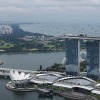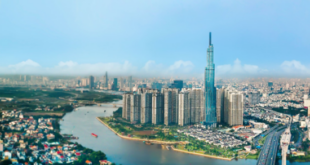Suppliers’ difficulties in acquiring bank loans, declining commissions for retailers and ineffective management by two ministries have pushed Vietnam into a gasoline conundrum that makes life more challenging for local citizens.
These days people in Ho Chi Minh City can be seen walking their motorbikes as they look for a place where gasoline is available since 137 gas stations, or 20% of the city’s total number, were running out of stocks as of Tuesday.
Provinces in the south, such as Binh Duong and Dong Nai, and the Central Highlands, such as Tay Nguyen and Dak Lak, have also been reporting shortages.
The shortage seems unusual in a country where there are 36 suppliers who either import gasoline from other countries or buy from the two domestic refineries, 500 distributors, and 17,000 gas stations.
Reportedly, many of the suppliers lack funds to buy fuel, the Ministry of Industry and Trade’s department of domestic market said in a report.
The head of supplier based in the south, who asked not be identified, said for VND3 billion (US$125,300) he used to be able to buy two ships worth of fuel, but now he can only buy one or one and a half.
“Borrowing from banks is challenging as their credit quotas have been reached.”
But admittedly the suppliers themselves are reluctant to buy fuel since global prices have been volatile in recent months posing higher risks of loss, the Ministry of Finance said.
In the third quarter gasoline imports fell by 40% and that of diesel by 35% with only 19 suppliers buying.
Adding to the difficulties was the penalty that trade ministry slapped on some suppliers for not meeting requirements such as having enough outlets, storage and transport vehicles. They had their licenses revoked for four to six weeks, causing a gap in supply to retailers.
The government deferred the penalty on five suppliers, but they have been unable to borrow from banks since they have finished their credit quotas.
Another challenge was Storm Noru, which upended plans by Saigon Petro to transport 12,000 cubic meters of gasoline from the refineries, both of which are in the central region, to the south.
Zero commission
Low commission for retailers is another problem exacerbating the situation. With the suppliers and distributors deciding the price at which fuel is sold to retailers, the latter’s profit depends on the difference between that price and the retail price set by the government.
If the government does not increase retail prices to reflect the higher costs of fuel or transportation, retailers evidently have to sell at very low profits or even at a loss, which has what happened in recent weeks.
Giang Chan Tay, who owns six fuel stations in Tra Vinh Province, said retailers like him are the last link in the supply chain but are neglected.
“The more we sell, the more we lose. Gas station owners fear they will lose more money and so are reluctant to buy more.”
Recently 36 retailers complained to Prime Minister Pham Minh Chinh that the Ministries of Finance and Industry and Trade do not factor in the costs of transporting fuel when setting the retail price, causing them losses.
Some of these costs, such as for transporting fuel domestically, have risen by seven or eight times in recent months, but the two ministries have delayed reflecting this increase in retail prices, they said.
Thus, fuel prices were cut nine times in the last three months, which has benefited consumers but not retailers, they said.
Le Van My, CEO of Hoc Mon Commercial Company which has 32 fuel stations in HCMC, said his company has run up losses of VND8 billion this year.
Bankruptcy looms if profits are not forthcoming, he added.
The trade ministry pointed fingers at the finance ministry saying it had called for reflecting the rising costs in retail prices on four occasions but the latter did not comply.
The finance ministry said ensuring adequate supply of fuel is the responsibility of the trade ministry and oil businesses.
On Tuesday gasoline retail prices were increased for the first time in nearly three months with the higher transportation costs finally being reflected.
Dinh Trong Thinh, a lecturer at the Vietnam Academy of Finance, said that there are issues in how the two ministries manage the gasoline market, such as a lack of transparency in the relationship between suppliers, distributors and retailers.
The trade ministry has not made correct calculations concerning the demand of each locality, he added.
Supervising imports quantity is necessary to see if suppliers follow their commitments, he said.
Long queues form at Hanoi gas stations as fuel shortage fears persist
- Reduce Hair Loss with PURA D’OR Gold Label Shampoo
- Castor Oil Has Made a “Huge” Difference With Hair and Brow Growth
- Excessive hair loss in men: Signs of illness that cannot be subjective
- Dịch Vụ SEO Website ở Los Angeles, CA: đưa trang web doanh nghiệp bạn lên top Google
- Nails Salon Sierra Madre
 VnExpress News The News Gateway of Vietnam
VnExpress News The News Gateway of Vietnam






